Efficient Evaluation of Concrete Fracture Surface Roughness Using Fringe Projection Technology
Abstract
1. Introduction
2. Materials and Methods
2.1. Concrete Specimens
2.2. Definition of Roughness
2.3. Measuring Principle
2.3.1. Phase Calculation
- Four-step phase-shifting method
- Phase unwrapping:
2.3.2. Phase-Height Calibration
2.3.3. Horizontal Calibration
3. Results and Discussion
3.1. Validation
3.2. Measurement of the Concrete Fracture Surface
4. Conclusions
- (1)
- The fringe-projection system achieved a measuring accuracy for a plane height of less than 0.1 mm and a relative accuracy for measuring a cylindrical object of about 0.1%, meeting the requirements for concrete fracture-surface measurement.
- (2)
- The unwrapped-phase correction method was experimentally validated and required only one additional strip image for fringe-order adjustment, ensuring measurement accuracy while improving efficiency.
- (3)
- The measurement of concrete fracture surfaces revealed that higher concrete strength was found to correlate with decreased roughness and fractal dimension, while an increased water-to-cement ratio led to increased roughness and fractal dimension. This finding highlights the relationship between concrete fracture surfaces and their mechanical properties.
- (4)
- In comparison to surface roughness, the fractal dimension is proved to be a more sensitive parameter for capturing changes in concrete surface shape.
Author Contributions
Funding
Institutional Review Board Statement
Informed Consent Statement
Data Availability Statement
Conflicts of Interest
References
- Chen, X.; Zhang, J.; Xiao, Y.; Li, J. Effect of roughness on shear behavior of red clay—Concrete interface in large-scale direct shear tests. Can. Geotech. J. 2015, 52, 1122–1135. [Google Scholar] [CrossRef]
- Mohamad, M.E.; Ibrahim, I.S.; Abdullah, R.; Rahman, A.B.A.; Kueh, A.B.H.; Usman, J. Friction and cohesion coefficients of composite concrete-to-concrete bond. Cem. Concr. Compos. 2015, 56, 1–14. [Google Scholar] [CrossRef]
- Tirassa, M.; Fernández Ruiz, M.; Muttoni, A. Influence of cracking and rough surface properties on the transfer of forces in cracked concrete. Eng. Struct. 2020, 225, 111138. [Google Scholar] [CrossRef]
- Sun, C.; Chen, Q.; Xiao, J.; Ge, W. Study on aggregate interlock behavior of pre-cracked recycled aggregate concrete without stirrups. J. Build. Eng. 2021, 39, 102257. [Google Scholar] [CrossRef]
- Ceia, F.; Raposo, J.; Guerra, M.; Júlio, E.; de Brito, J. Shear strength of recycled aggregate concrete to natural aggregate concrete interfaces. Constr. Build. Mater. 2016, 109, 139–145. [Google Scholar] [CrossRef]
- Bogoviku, L.; Waldmann, D. Experimental investigations on the interfacial bond strength of the adhered mortar paste to the new mortar paste in a recycled concrete matrix. Constr. Build. Mater. 2022, 347, 128509. [Google Scholar] [CrossRef]
- You, Z.; Wang, L.; Yang, Y.; Shi, C. Anisotropic research on shear strength parameters of discontinuity based on three-dimensional laser scanning technology. Chin. J. Rock Mech. Eng. 2014, 33, 3003–3008. [Google Scholar] [CrossRef]
- Valikhani, A.; Jaberi Jahromi, A.; Pouyanfar, S.; Mantawy, I.M.; Azizinamini, A. Machine learning and image processing approaches for estimating concrete surface roughness using basic cameras. Comput. Aided Civ. Infrastruct. Eng. 2020, 36, 213–226. [Google Scholar] [CrossRef]
- Garbacz, A.; Courard, L.; Bissonnette, B. A surface engineering approach applicable to concrete repair engineering. Bull. Pol. Acad. Sci. Tech. Sci. 2013, 61, 73–84. [Google Scholar] [CrossRef]
- Zhang, X.; Zhang, L. Characterization and properties of artificial roughness of young and old concrete bonding interface. J. Hepatol. 2013, 41, 753–758. [Google Scholar]
- Aggelis, D.G.; Mpalaskas, A.C.; Matikas, T.E.; Van Hemelrijck, D. Acoustic emission signatures of damage modes in concrete. In Proceedings of the SPIE 9062, Smart Sensor Phenomena, Technology, Networks, and Systems Integration, San Diego, CA, USA, 8 March 2014. [Google Scholar] [CrossRef]
- Chalioris, C.E.; Kytinou, V.K.; Voutetaki, M.E.; Karayannis, C.G. Flexural Damage Diagnosis in Reinforced Concrete Beams Using a Wireless Admittance Monitoring System—Tests and Finite Element Analysis. Sensors 2021, 21, 679. [Google Scholar] [CrossRef] [PubMed]
- Pranno, A.; Greco, F.; Lonetti, P.; Luciano, R.; De Maio, U. An improved fracture approach to investigate the degradation of vibration characteristics for reinforced concrete beams under progressive damage. Int. J. Fatigue 2022, 163, 107032. [Google Scholar] [CrossRef]
- Hoła, J.; Sadowski, Ł.; Reiner, J.; Stach, S. Usefulness of 3D surface roughness parameters for nondestructive evaluation of pull-off adhesion of concrete layers. Constr. Build. Mater. 2015, 84, 111–120. [Google Scholar] [CrossRef]
- Issa, M.A.; Issa, M.A.; Islam, M.S.; Chudnovsky, A. Fractal dimension––A measure of fracture roughness and toughness of concrete. Eng. Fract. Mech. 2003, 70, 125–137. [Google Scholar] [CrossRef]
- Nasrollahzadeh, K.; Afzali, S. Fuzzy logic model for pullout capacity of near-surface-mounted FRP reinforcement bonded to concrete. Neural Comput. Appl. 2019, 31, 7837–7865. [Google Scholar] [CrossRef]
- Sadowski, Ł.; Mathia, T.G. Multi-scale metrology of concrete surface morphology: Fundamentals and specificity. Constr. Build. Mater. 2016, 113, 613–621. [Google Scholar] [CrossRef]
- Zhang, B.; Shen, Q.; Zhao, Y.; Zhou, L. Review of research progress on roughness qualification methods for joint surfaces of precast concrete components. Build. Sci. 2019, 35, 39–45. [Google Scholar] [CrossRef]
- Santos, P.M.D.; Júlio, E.N.B.S. A state-of-the-art review on roughness quantification methods for concrete surfaces. Constr. Build. Mater. 2013, 38, 912–923. [Google Scholar] [CrossRef]
- Garbacz, A.; Courard, L.; Kostana, K. Characterization of concrete surface roughness and its relation to adhesion in repair systems. Mater. Charact. 2006, 56, 281–289. [Google Scholar] [CrossRef]
- Abu-Tair, A.I.; Lavery, D.; Nadjai, A.; Rigden, S.R.; Ahmed, T.M.A. A new method for evaluating the surface roughness of concrete cut for repair or strengthening. Constr. Build. Mater. 2000, 14, 171–176. [Google Scholar] [CrossRef]
- Santos, P.M.D.; Júlio, E.N.B.S.; Silva, V.D. Correlation between concrete-to-concrete bond strength and the roughness of the substrate surface. Constr. Build. Mater. 2007, 21, 1688–1695. [Google Scholar] [CrossRef]
- ICRI. Selecting and Specifying Concrete Surface Preparation for Sealers, Coatings, and Polymer Overlays; Technical Guideline No. 03732; ICRI: Des Plaines, IL, USA, 1997. [Google Scholar]
- E965-96; Standard Test Method for Measuring Pavement Macrotexture Depth Using a Volumetric Technique. ASTM: West Conshohocken, PA, USA, 2001.
- Zhao, Z.; Yu, Y.; Zhao, G. Method for measuring the roughness of the bonding surface between new and old concrete. Build. Struct. 2000, 1, 26–29. [Google Scholar] [CrossRef]
- Zhang, B.; Shen, Q.; Zhao, Y.; Zhou, L. Study on roughness qualification for joint surfaces of precast concrete components: A 3D-laser-scan-based approach. Build. Sci. 2020, 36, 111–116. [Google Scholar] [CrossRef]
- Wu, K.; Yan, A.; Liu, J.; Zhang, D.; Yao, W. Reconstruction and analysis of 3-D profile of fracture surface of concrete. Cem. Concr. Res. 2000, 30, 981–987. [Google Scholar] [CrossRef]
- Dai, M.; Yang, F.; Liu, C.; He, X. A dual-frequency fringe projection three-dimensional shape measurement system using a DLP 3D projector. Opt. Commun. 2017, 382, 294–301. [Google Scholar] [CrossRef]
- Dai, M.; Yang, F.; He, X. Single-shot color fringe projection for three-dimensional shape measurement of objects with discontinuities. Appl. Opt. 2012, 51, 2062–2069. [Google Scholar] [CrossRef]
- Zhang, S. Absolute phase retrieval methods for digital fringe projection profilometry: A review. Opt. Lasers Eng. 2018, 107, 28–37. [Google Scholar] [CrossRef]
- Zuo, C.; Huang, L.; Zhang, M.; Chen, Q.; Asundi, A. Temporal phase unwrapping algorithms for fringe projection profilometry: A comparative review. Opt. Lasers Eng. 2016, 85, 84–103. [Google Scholar] [CrossRef]
- Ghiglia, D.C.; Pritt, M.D. Two-Dimensional Phase Unwrapping: Theory, Algorithms, and Software; Wiley: Hoboken, NJ, USA, 1998. [Google Scholar]
- Lu, Y.; Wang, X.; He, G. Phase unwrapping based on branch cut placing and reliability ordering. Opt. Eng. 2005, 44, 055601. [Google Scholar] [CrossRef]
- Lu, Y.; Wang, X.; Zhong, X.; He, G.; Liu, Y.; Zheng, D. A new quality map for quality-guided phase unwrapping. Chin. Opt. Lett. 2004, 2, 698–700. [Google Scholar]
- Dai, M.; Chen, L.; Yang, F.; He, X. Calibration of revolution axis for 360 deg surface measurement. Appl. Opt. 2013, 52, 5440–5448. [Google Scholar] [CrossRef] [PubMed]
- Mechtcherine, V. Fracture mechanical behavior of concrete and the condition of its fracture surface. Cem. Concr. Res. 2009, 39, 620–628. [Google Scholar] [CrossRef]
- Yan, A.; Wu, K.R.; Zhang, D.; Yao, W. Influence of concrete composition on the characterization of fracture surface. Cem. Concr. Compos. 2003, 25, 153–157. [Google Scholar] [CrossRef]
- Zhao, M.; Huang, L.; Zhang, Q.; Su, X.; Asundi, A.; Kemao, Q. Quality-guided phase unwrapping technique: Comparison of quality maps and guiding strategies. Appl. Opt. 2011, 50, 6214–6224. [Google Scholar] [CrossRef]
- Zhang, S.; Li, X.; Yau, S.T. Multilevel quality-guided phase unwrapping algorithm for real-time three-dimensional shape reconstruction. Appl. Opt. 2007, 46, 50–57. [Google Scholar] [CrossRef]
- Hartley, R.; Zisserman, A. Multiple View Geometry in Computer Vision; Cambridge University Press: Cambridge, UK, 2000. [Google Scholar]
- GBT 50081-2019; Standard for Test Methods of Concrete Physical and Mechanical Properties. Ministry of Housing and Urban-Rural Development of the PRC: Beijing, China, 2019.
- Yan, A.; Wu, K.R.; Zhang, D.; Yao, W. Effect of fracture path on the fracture energy of high-strength concrete. Cem. Concr. Res. 2001, 31, 1601–1606. [Google Scholar] [CrossRef]
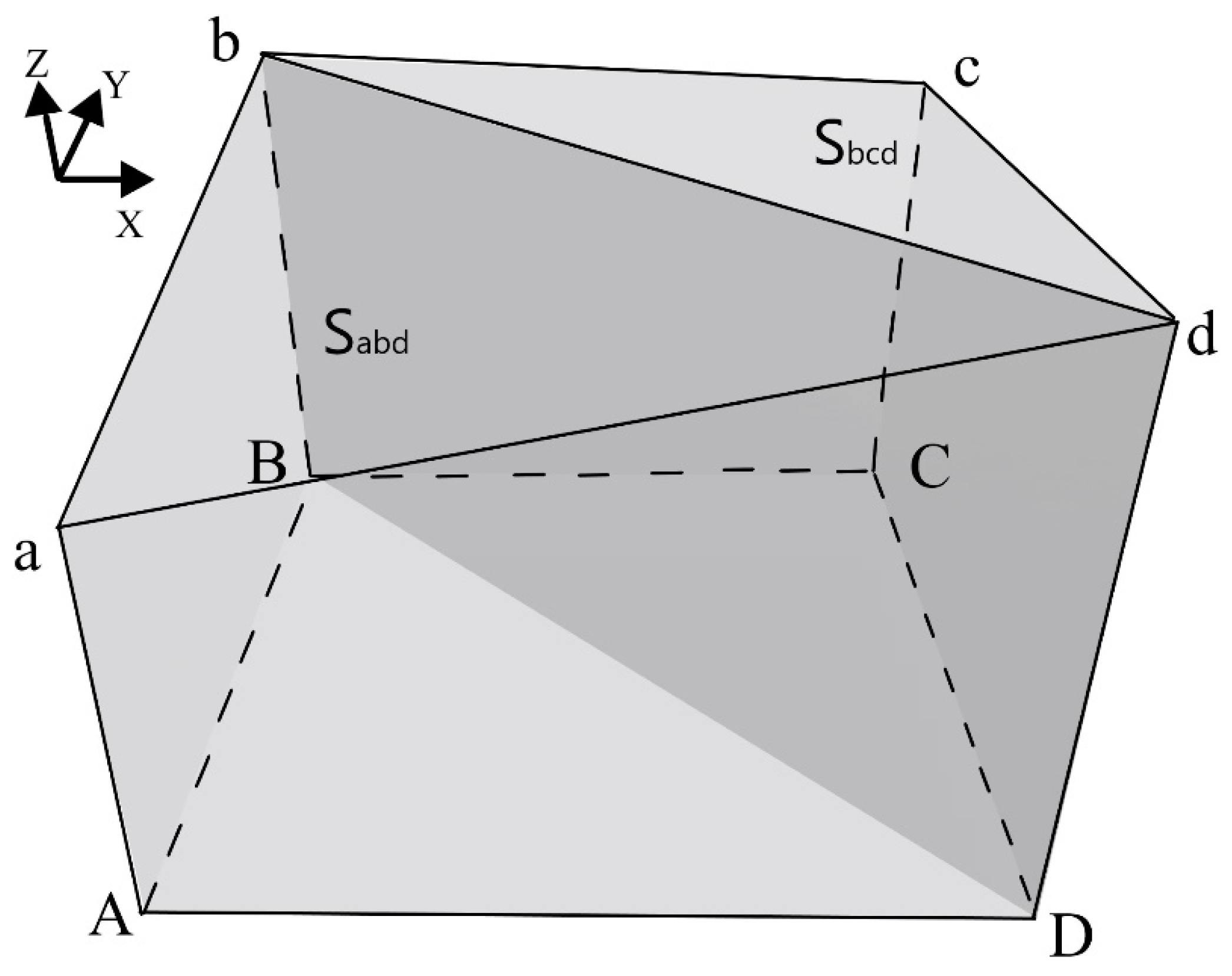
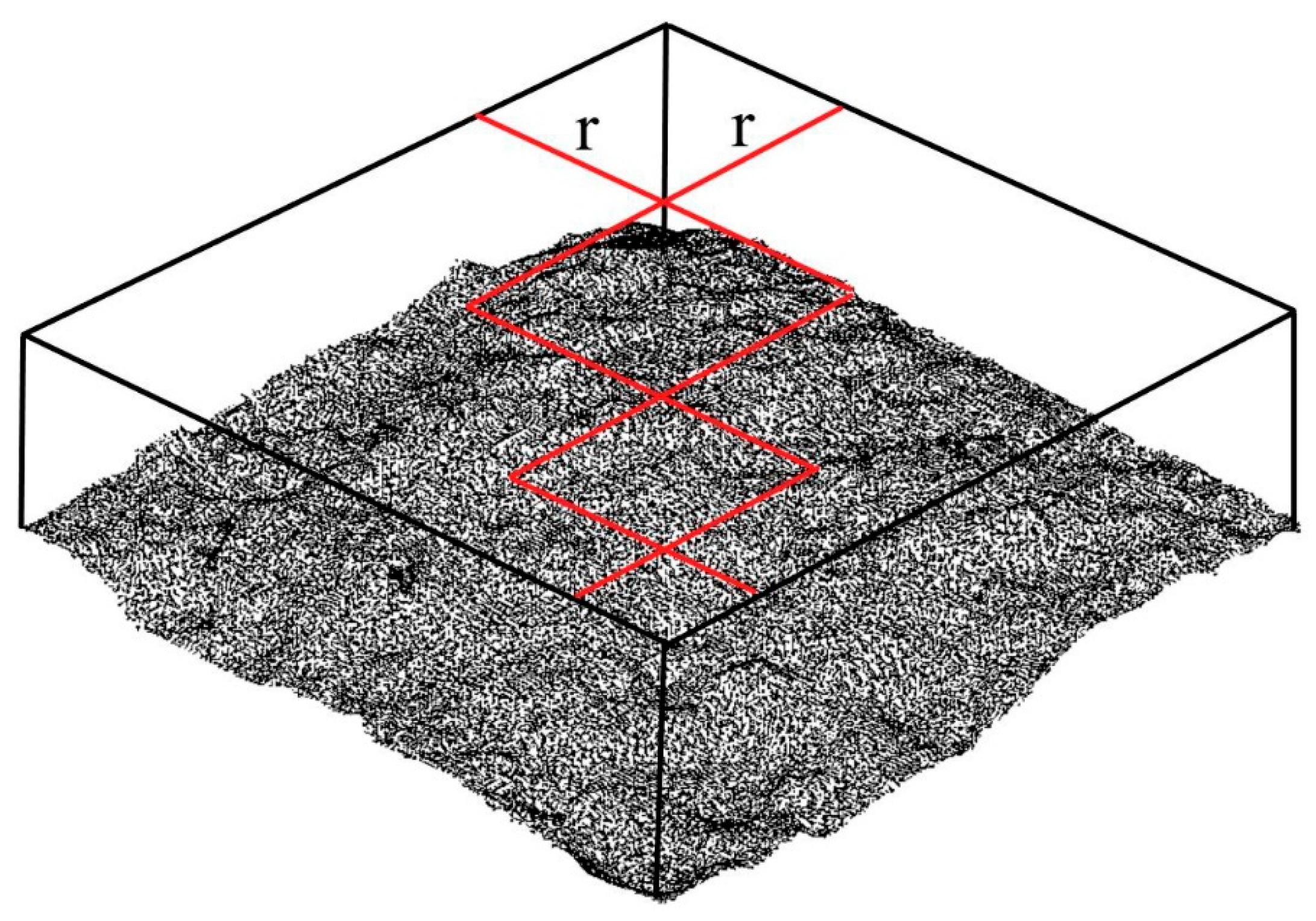
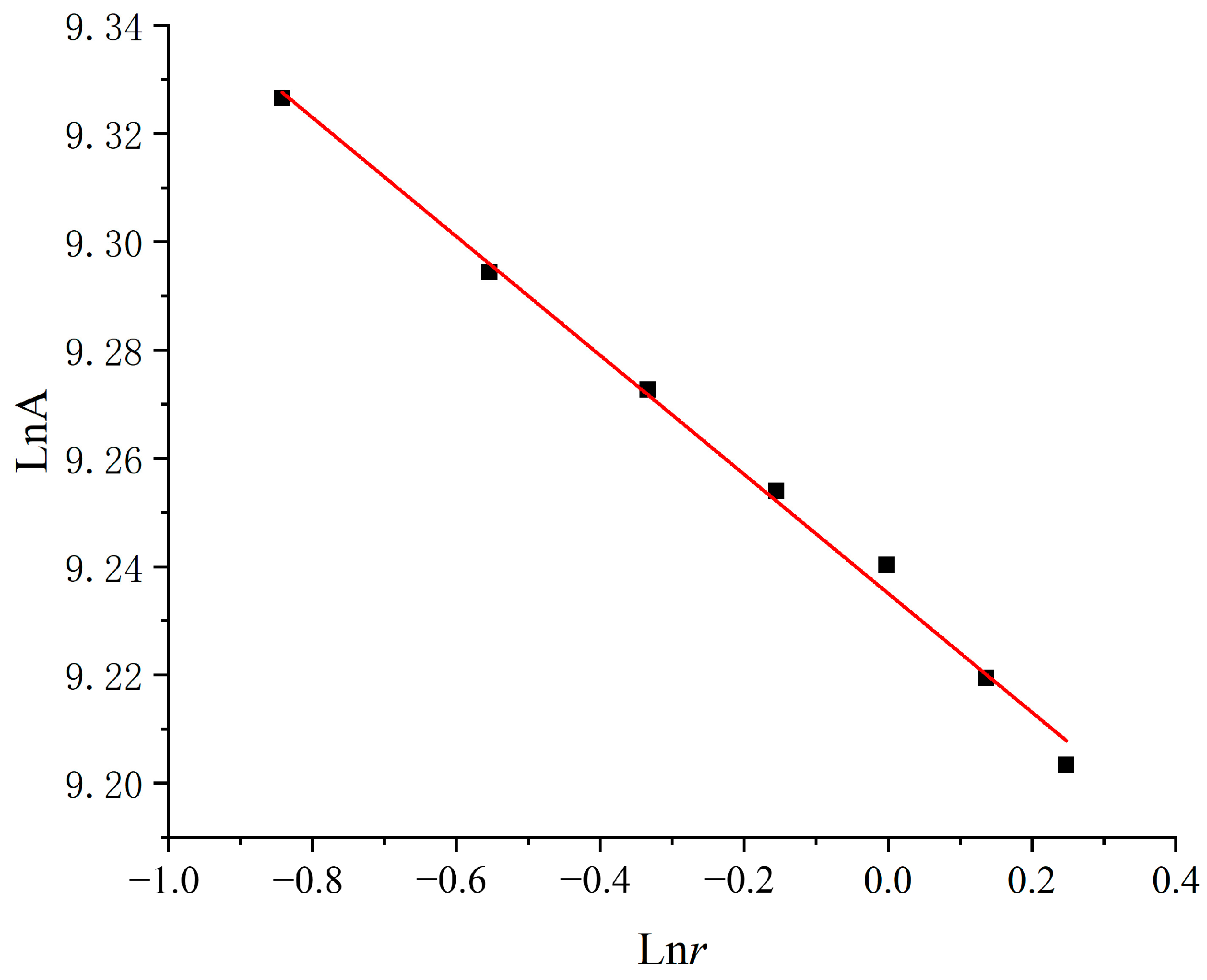

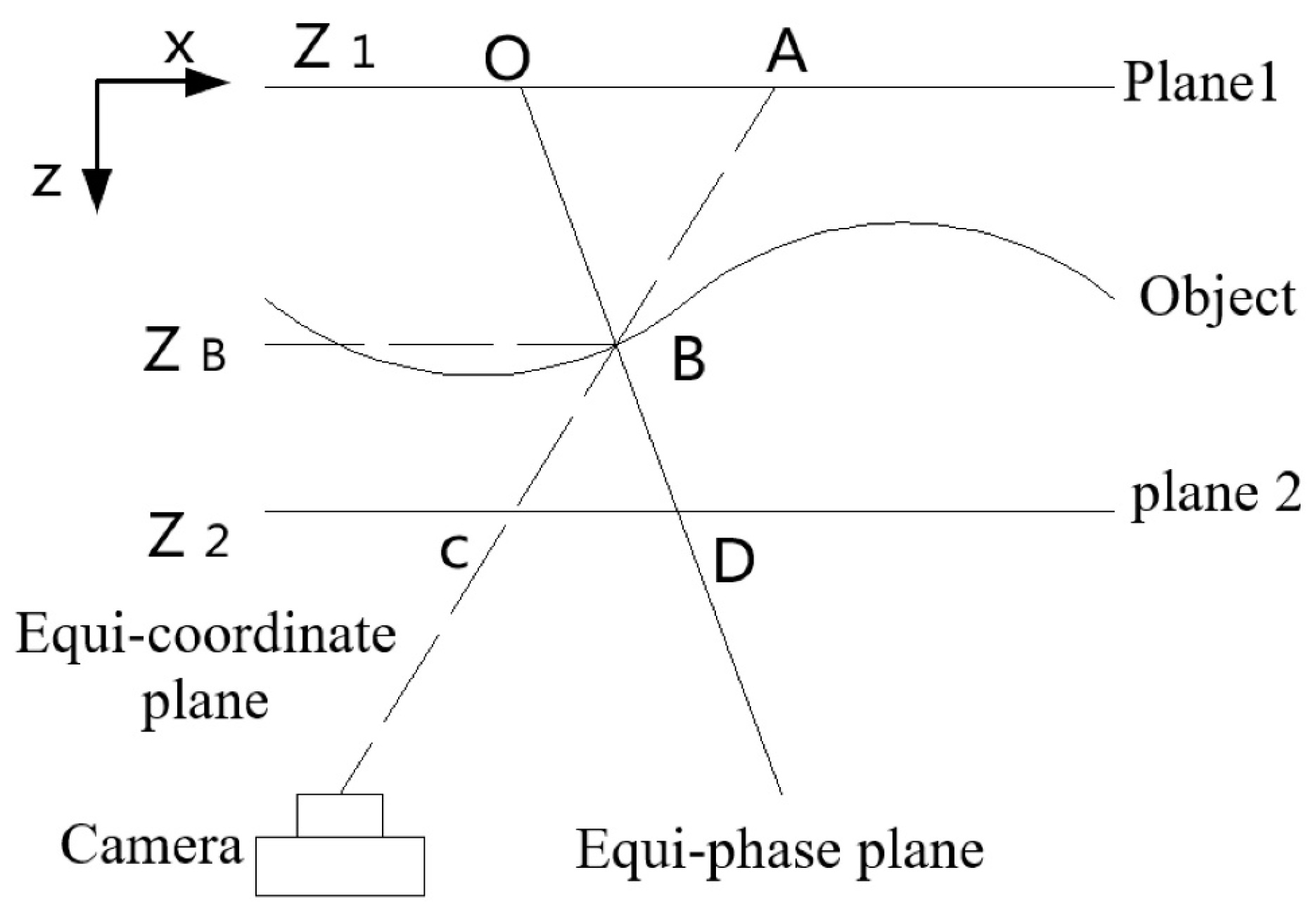


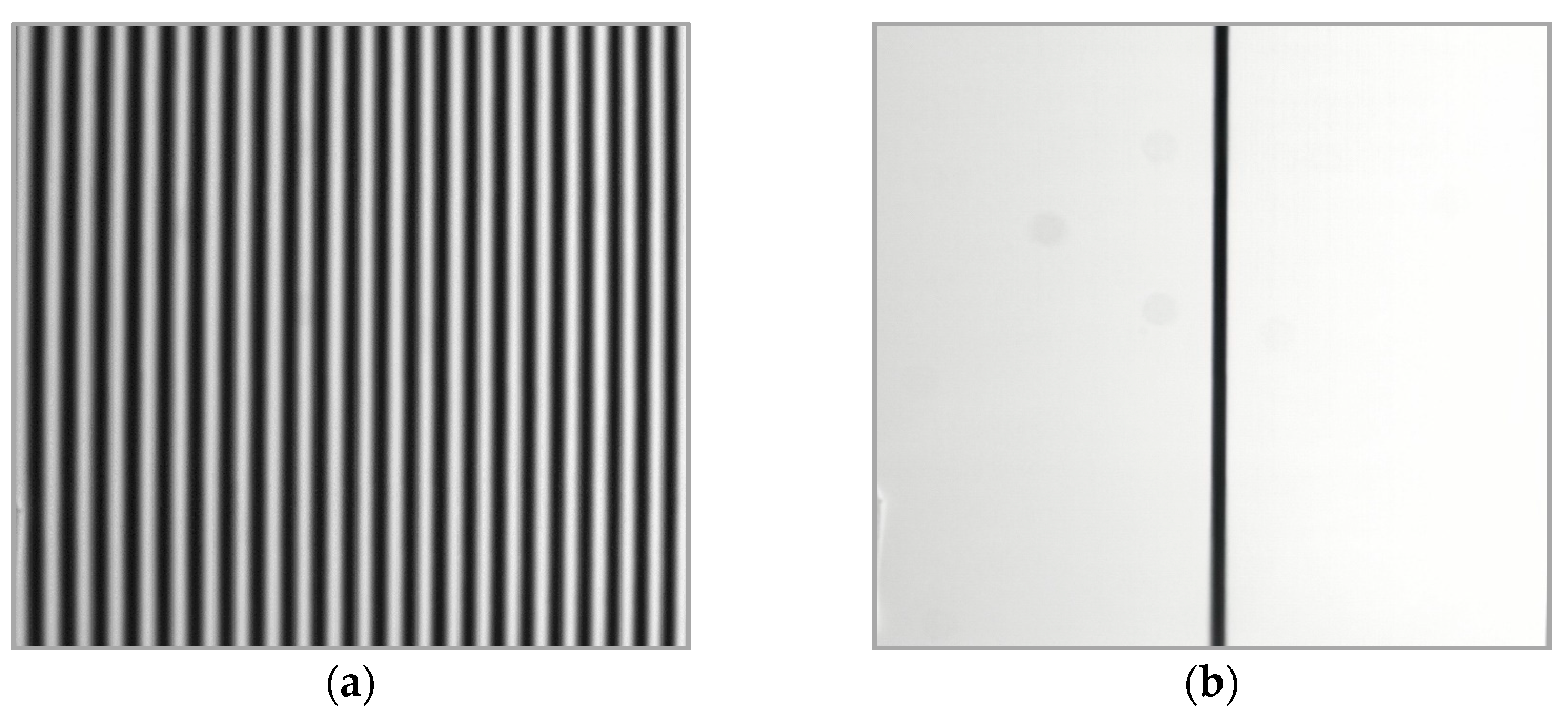


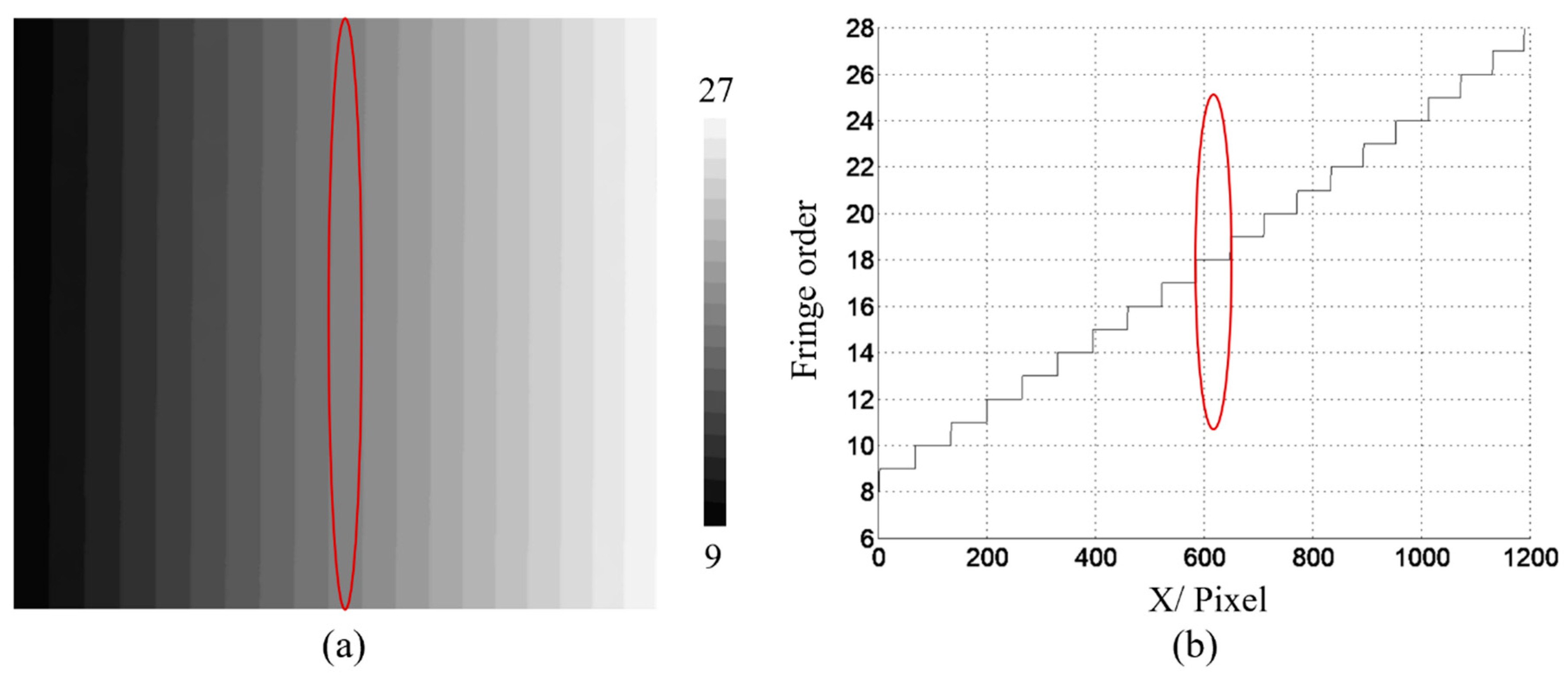

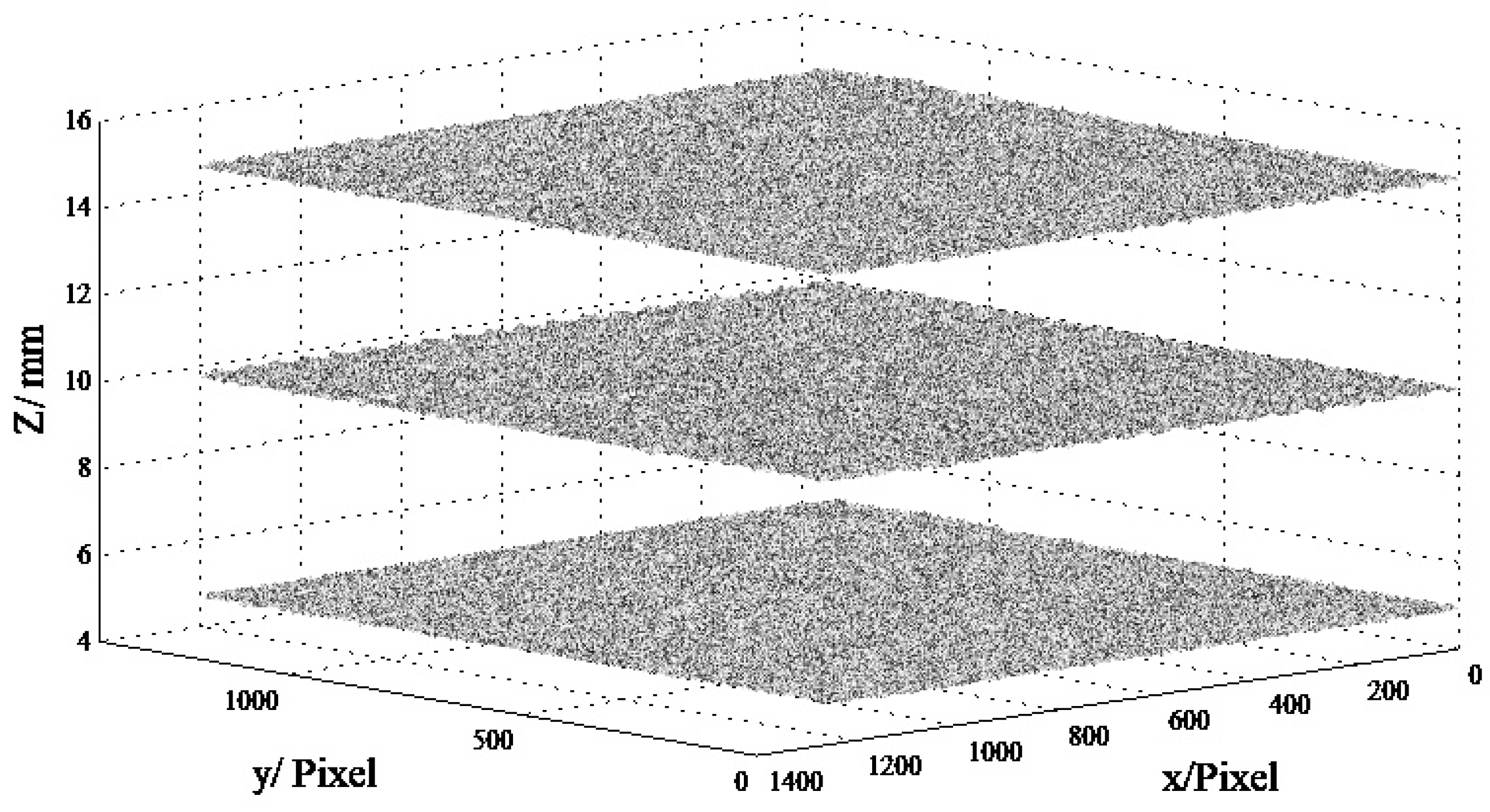


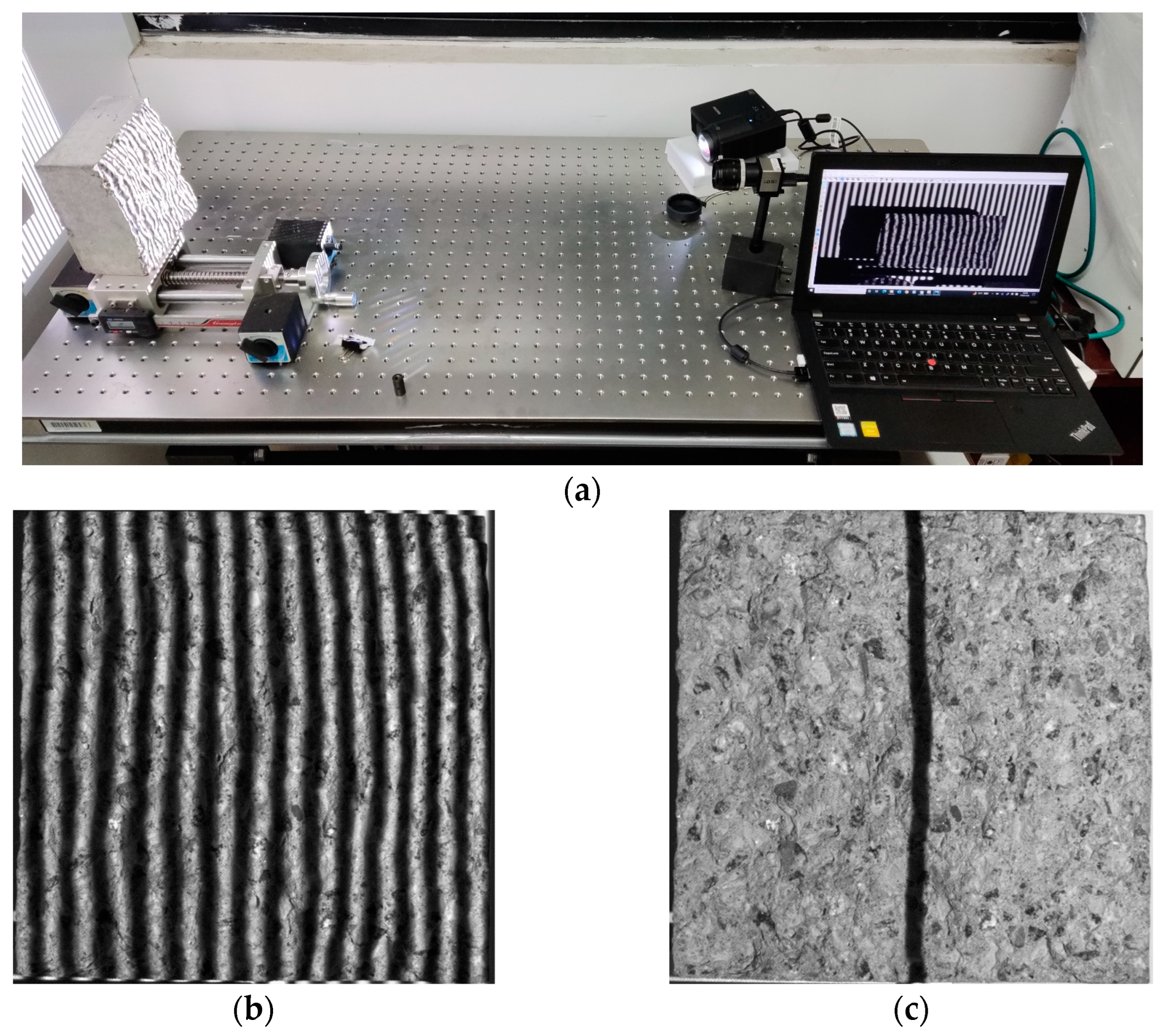

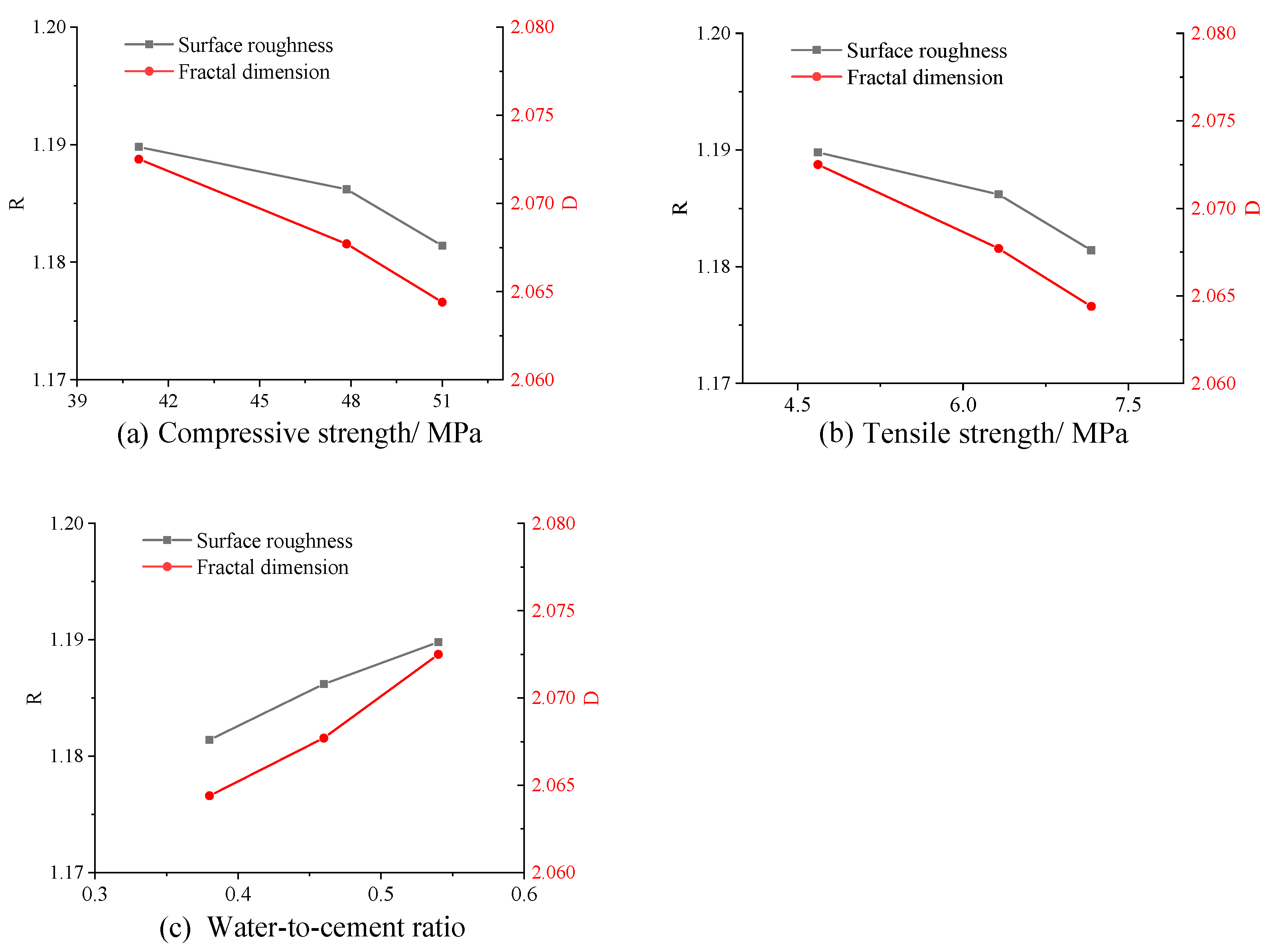
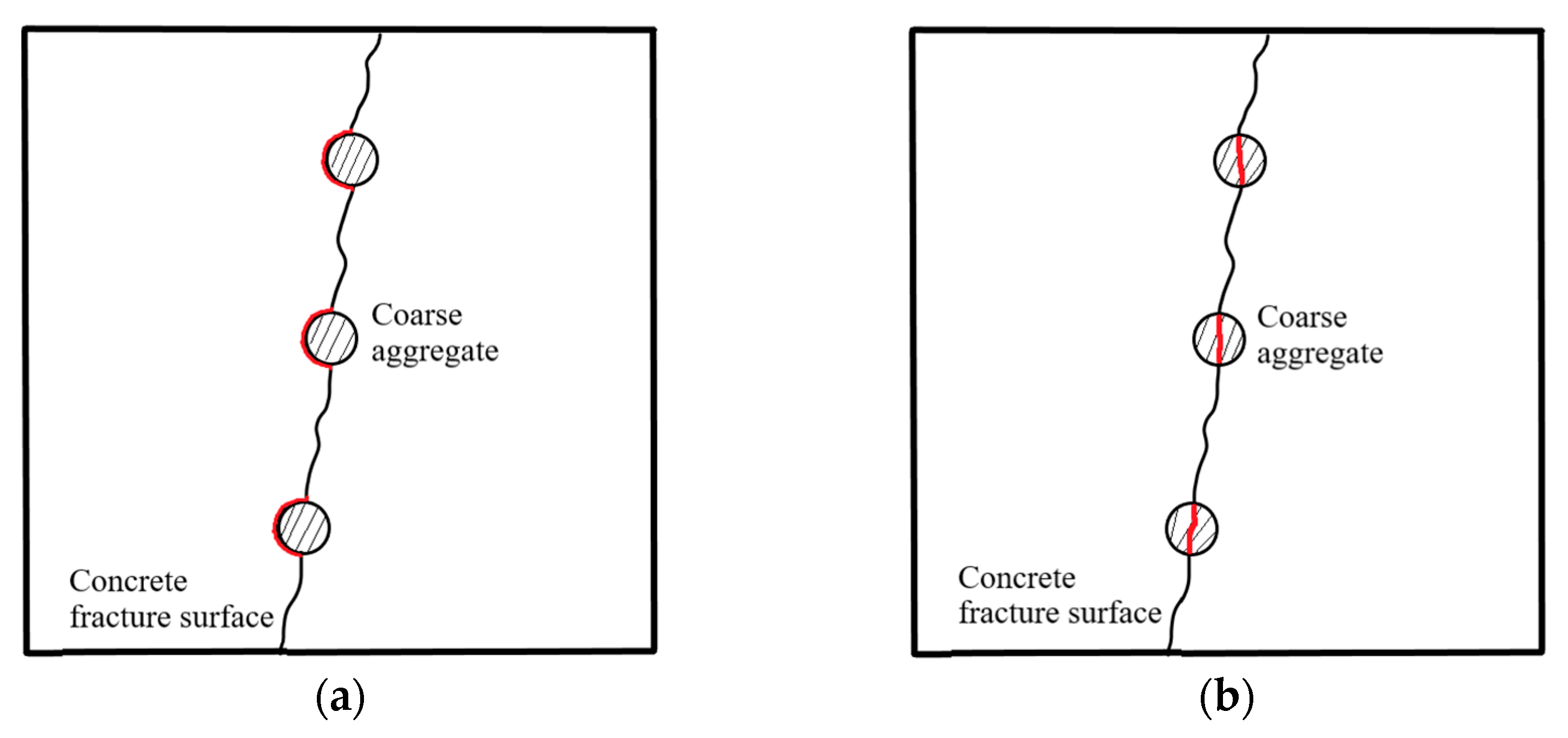
| Type | Water | Cement | Sand | Coarse |
|---|---|---|---|---|
| C20 | 210 | 388.9 | 630.7 | 1171.3 |
| C30 | 210 | 456.5 | 606.7 | 1126.8 |
| C40 | 210 | 552.6 | 573.09 | 1064.31 |
| Concrete Specimens | Water-to-Cement Ratio | Compressive Strength (MPa) | Splitting Strength (MPa) |
|---|---|---|---|
| C20 | 0.54 | 41.031 | 4.684 |
| C30 | 0.46 | 47.859 | 6.324 |
| C40 | 0.38 | 51.003 | 7.164 |
| Concrete Specimens | Surface Roughness (R) | Fractal Dimension (D) |
|---|---|---|
| C20 | 1.1898 | 2.0725 |
| C30 | 1.1862 | 2.0677 |
| C40 | 1.1814 | 2.0644 |
Disclaimer/Publisher’s Note: The statements, opinions and data contained in all publications are solely those of the individual author(s) and contributor(s) and not of MDPI and/or the editor(s). MDPI and/or the editor(s) disclaim responsibility for any injury to people or property resulting from any ideas, methods, instructions or products referred to in the content. |
© 2023 by the authors. Licensee MDPI, Basel, Switzerland. This article is an open access article distributed under the terms and conditions of the Creative Commons Attribution (CC BY) license (https://creativecommons.org/licenses/by/4.0/).
Share and Cite
Dai, M.; Wang, X.; Cheng, C.; Chen, Z.; Deng, J. Efficient Evaluation of Concrete Fracture Surface Roughness Using Fringe Projection Technology. Materials 2023, 16, 4430. https://doi.org/10.3390/ma16124430
Dai M, Wang X, Cheng C, Chen Z, Deng J. Efficient Evaluation of Concrete Fracture Surface Roughness Using Fringe Projection Technology. Materials. 2023; 16(12):4430. https://doi.org/10.3390/ma16124430
Chicago/Turabian StyleDai, Meiling, Xirui Wang, Cheng Cheng, Zhuoli Chen, and Jiyu Deng. 2023. "Efficient Evaluation of Concrete Fracture Surface Roughness Using Fringe Projection Technology" Materials 16, no. 12: 4430. https://doi.org/10.3390/ma16124430
APA StyleDai, M., Wang, X., Cheng, C., Chen, Z., & Deng, J. (2023). Efficient Evaluation of Concrete Fracture Surface Roughness Using Fringe Projection Technology. Materials, 16(12), 4430. https://doi.org/10.3390/ma16124430





